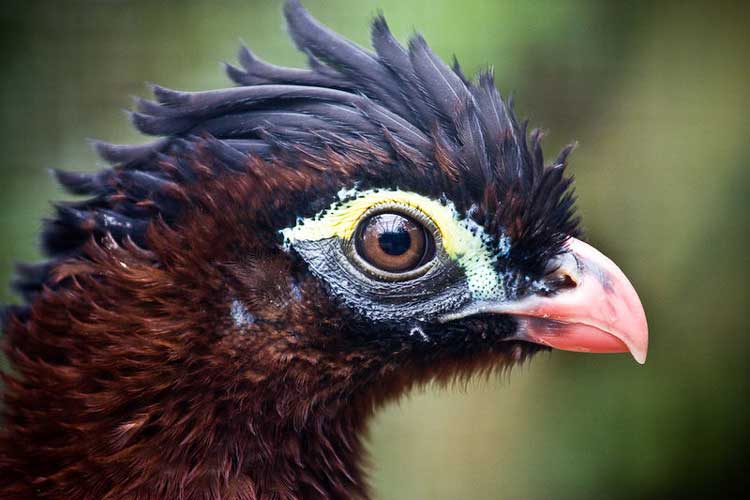
Nothocrax urumutum (*)
Superregnum: Eukaryota
Cladus: Unikonta
Cladus: Opisthokonta
Cladus: Holozoa
Regnum: Animalia
Subregnum: Eumetazoa
Cladus: Bilateria
Cladus: Nephrozoa
Superphylum: Deuterostomia
Phylum: Chordata
Subphylum: Vertebrata
Infraphylum: Gnathostomata
Megaclassis: Osteichthyes
Cladus: Sarcopterygii
Cladus: Rhipidistia
Cladus: Tetrapodomorpha
Cladus: Eotetrapodiformes
Cladus: Elpistostegalia
Superclassis: Tetrapoda
Cladus: Reptiliomorpha
Cladus: Amniota
Classis: Reptilia
Cladus: Eureptilia
Cladus: Romeriida
Subclassis: Diapsida
Cladus: Sauria
Infraclassis: Archosauromorpha
Cladus: Crurotarsi
Divisio: Archosauria
Cladus: Avemetatarsalia
Cladus: Ornithodira
Subtaxon: Dinosauromorpha
Cladus: Dinosauriformes
Cladus: Dracohors
Cladus: Dinosauria
Ordo: Saurischia
Cladus: Eusaurischia
Subordo: Theropoda
Cladus: Neotheropoda
Cladus: Averostra
Cladus: Tetanurae
Cladus: Avetheropoda
Cladus: Coelurosauria
Cladus: Tyrannoraptora
Cladus: Maniraptoromorpha
Cladus: Maniraptoriformes
Cladus: Maniraptora
Cladus: Pennaraptora
Cladus: Paraves
Cladus: Eumaniraptora
Cladus: Avialae
Infraclassis: Aves
Cladus: Euavialae
Cladus: Avebrevicauda
Cladus: Pygostylia
Cladus: Ornithothoraces
Cladus: Ornithuromorpha
Cladus: Carinatae
Parvclassis: Neornithes
Cohors: Neognathae
Cladus: Pangalloanserae
Cladus: Galloanseres
Ordo: Galliformes
Subordo: Craci
Familia: Cracidae
Genus: Nothocrax
Species: Nothocrax urumutum
Name
Nothocrax urumutum (Spix, 1825)
References
Avium species novae, quas Brasiliam anus MDCCCXVII - MDCCCXX 2 p. 49 pl.62
Vernacular names
English: Nocturnal Curassow
français: Hocco nocturne
português: Urumutum
svenska: Natthocko
The nocturnal curassow (Nothocrax urumutum) is a species of bird in the family Cracidae, the chachalacas, guans, and curassows. It is found in Brazil, Colombia, Ecuador, Peru, and Venezuela.[2][3]
Taxonomy and systematics
The nocturnal curassow was originally placed in genus Crax but genetic data confirm that Nothocrax is a valid genus.[4] It is the only member of its genus and has no subspecies.[2]
Description
The nocturnal curassow is the smallest curassow at 50 to 57.5 cm (1.6 to 1.9 ft) long. One bird weighed 1,250 g (2.8 lb). It is also unique with its mostly rufous and chestnut plumage, as other curassows are mostly black. Its crest is flat and blackish, its ventral area buffy, and the tips of its tail feathers are paler than the rest. Its brownish orange eye is surrounded by bare skin, greenish yellow above and black below. The bill is reddish orange and the legs gray.[5]
Distribution and habitat
The nocturnal curassow is found in middle and upper Amazonia, from far southern Venezuela, southeastern Colombia, eastern Ecuador, and northeastern Peru into western and central Brazil. It inhabits terra firme forest and flooded forests (both permanent and seasonal). It favors low lying, gentle, terrain, often near blackwater rivers. It is typically found below 850 m (2,800 ft) but has been recorded as high as about 1,500 m (4,900 ft) in Ecuador.[5]
Behavior
Belying its name, the nocturnal curassow is active in daylight as well as night and twilight, though it sings only at night.
Feeding
The nocturnal curassow forages singly or in groups of up to four birds, at dawn, dusk, and the few hours after or before them. It feeds on the ground, apparently entirely on vegetable matter though its diet has not been extensively studied.[5]
Breeding
The nocturnal curassow's breeding season has not been determined, but breeding activity has been noted between October and February. It makes a large loosely woven nest from sticks and palm leaves lined with twigs and dried leaves. Nests have been found high in trees and vines and also on stumps and logs near the ground. The clutch size is two eggs.[5]
Dickcissel male perched on a metal pole singing, with neck stretched and beak open.
Songs and calls
Listen to nocturnal curassow on xeno-canto
Vocalization
The nocturnal curassow sings only at night, primarily on clear dark nights in dry weather. Its song is "a series of seven, low-pitched, highly resonant notes...rendered 'hmm-hmm-hmmmm, hmm hmm-hmmm, hmmph!'." Sometimes several birds will counter-sing.[5]
Status
The IUCN has assessed the nocturnal curassow as being of Least Concern.[1] Much of its range in western Amazonia remains intact and its mostly nocturnal habits apparently lead to less hunting pressure than other Cracids experience.[5]
References
BirdLife International (2016). "Nocturnal Curassow Nothocrax urumutum". IUCN Red List of Threatened Species. 2016. Retrieved 2 October 2021.
Gill, F.; Donsker, D.; Rasmussen, P. (July 2021). "IOC World Bird List (v 11.2)". Retrieved July 14, 2021.
Remsen, J. V., Jr., J. I. Areta, E. Bonaccorso, S. Claramunt, A. Jaramillo, D. F. Lane, J. F. Pacheco, M. B. Robbins, F. G. Stiles, and K. J. Zimmer. Version 24 August 2021. Species Lists of Birds for South American Countries and Territories. https://www.museum.lsu.edu/~Remsen/SACCCountryLists.htm retrieved August 24, 2021
Remsen, J. V., Jr., J. I. Areta, E. Bonaccorso, S. Claramunt, A. Jaramillo, D. F. Lane, J. F. Pacheco, M. B. Robbins, F. G. Stiles, and K. J. Zimmer. Version 24 August 2021. A classification of the bird species of South America. American Ornithological Society. https://www.museum.lsu.edu/~Remsen/SACCBaseline.htm retrieved 24 August 2021
del Hoyo, J. and G. M. Kirwan (2020). Nocturnal Curassow (Nothocrax urumutum), version 1.0. In Birds of the World (J. del Hoyo, A. Elliott, J. Sargatal, D. A. Christie, and E. de Juana, Editors). Cornell Lab of Ornithology, Ithaca, NY, USA. https://doi.org/10.2173/bow.noccur1.01 retrieved October 2, 2021
Retrieved from "http://en.wikipedia.org/"
All text is available under the terms of the GNU Free Documentation License

